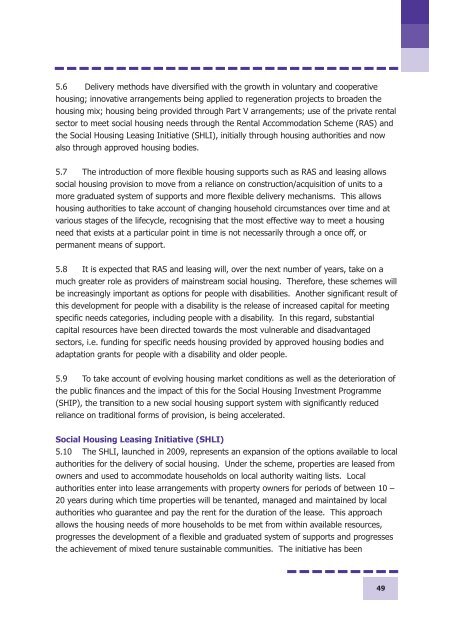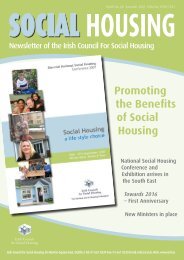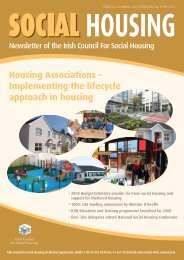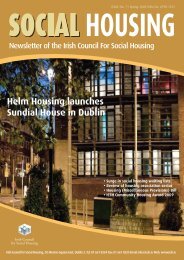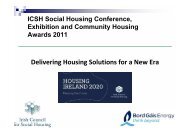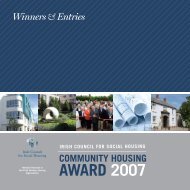National Housing Strategy for People with a Disability 2011 - 2016
National Housing Strategy for People with a Disability 2011 - 2016
National Housing Strategy for People with a Disability 2011 - 2016
Create successful ePaper yourself
Turn your PDF publications into a flip-book with our unique Google optimized e-Paper software.
5.6 Delivery methods have diversified <strong>with</strong> the growth in voluntary and cooperativehousing; innovative arrangements being applied to regeneration projects to broaden thehousing mix; housing being provided through Part V arrangements; use of the private rentalsector to meet social housing needs through the Rental Accommodation Scheme (RAS) andthe Social <strong>Housing</strong> Leasing Initiative (SHLI), initially through housing authorities and nowalso through approved housing bodies.5.7 The introduction of more flexible housing supports such as RAS and leasing allowssocial housing provision to move from a reliance on construction/acquisition of units to amore graduated system of supports and more flexible delivery mechanisms. This allowshousing authorities to take account of changing household circumstances over time and atvarious stages of the lifecycle, recognising that the most effective way to meet a housingneed that exists at a particular point in time is not necessarily through a once off, orpermanent means of support.5.8 It is expected that RAS and leasing will, over the next number of years, take on amuch greater role as providers of mainstream social housing. There<strong>for</strong>e, these schemes willbe increasingly important as options <strong>for</strong> people <strong>with</strong> disabilities. Another significant result ofthis development <strong>for</strong> people <strong>with</strong> a disability is the release of increased capital <strong>for</strong> meetingspecific needs categories, including people <strong>with</strong> a disability. In this regard, substantialcapital resources have been directed towards the most vulnerable and disadvantagedsectors, i.e. funding <strong>for</strong> specific needs housing provided by approved housing bodies andadaptation grants <strong>for</strong> people <strong>with</strong> a disability and older people.5.9 To take account of evolving housing market conditions as well as the deterioration ofthe public finances and the impact of this <strong>for</strong> the Social <strong>Housing</strong> Investment Programme(SHIP), the transition to a new social housing support system <strong>with</strong> significantly reducedreliance on traditional <strong>for</strong>ms of provision, is being accelerated.Social <strong>Housing</strong> Leasing Initiative (SHLI)5.10 The SHLI, launched in 2009, represents an expansion of the options available to localauthorities <strong>for</strong> the delivery of social housing. Under the scheme, properties are leased fromowners and used to accommodate households on local authority waiting lists. Localauthorities enter into lease arrangements <strong>with</strong> property owners <strong>for</strong> periods of between 10 –20 years during which time properties will be tenanted, managed and maintained by localauthorities who guarantee and pay the rent <strong>for</strong> the duration of the lease. This approachallows the housing needs of more households to be met from <strong>with</strong>in available resources,progresses the development of a flexible and graduated system of supports and progressesthe achievement of mixed tenure sustainable communities. The initiative has been49


